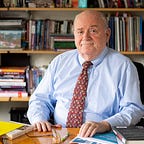Why Our Higher Education System Is Split into Unequal Tracks Divided by Race
By Anthony P. Carnevale
The promise of American higher education is to promote human flourishing and equal opportunities to students of all backgrounds. But what we see in today’s colleges is a far cry from a united path to prosperity — it’s a chasm demarcated by race. So, how did that promise become racially separate and unequal tracks?
Beginning in the 1990s, White students fled the underfunded and overcrowded two-year and four-year open-access colleges for the nation’s top 500 or so universities. While that was happening, Black/African American and Hispanic/Latino students collectively doubled their college enrollment numbers yet predominantly attended (75%) open-access colleges.
What we see is a cycle of racial privilege. White students educated at top colleges go on to have successful careers, marry other White individuals with similar backgrounds, and buy homes in neighborhoods that give their kids access to a top education from pre-K through high school that prepares them for selective colleges. And then the cycle repeats and strengthens across generations.
So, what accounts for the differences between open-access colleges and selective schools?
- Money: Highly unequal spending between the top universities and open-access colleges drives unequal student outcomes. In fact, the top 500 universities spend between two and five times as much per student compared to open-access colleges.
- Graduation rates: Graduation rates: The differences in graduation rates among equally-qualified students by college type are striking: 84 percent of students at top universities graduate compared to only 52 percent of equally-qualified students at open-access colleges. Equally-qualified Black/African American and Hispanic/Latino students with above average SAT/ACT scores do better at top universities — 73 percent of them graduate. But only 40 percent of these students graduate at open-access colleges.
- Wage gaps: Black/African American and Hispanic/Latino individuals who graduate from top universities earn 21 percent more than those who graduate from open-access colleges. Even so, the wage gap among the races persists: for every dollar a White worker earns, a Black/African American worker gets paid 76 cents and a Hispanic/Latino worker earns 68 cents. Much of that is explained by the fact that White individuals, on average, have higher levels of educational attainment than Black/African American or Hispanic/Latino individuals.How can we regain some balance?
- Test scores: Everyone pays a lot of attention to standardized test scores, but these scores explain less than half the difference in graduation rates. A student with an average SAT score would have an 80 percent chance of graduating from a top university but has almost no chance of getting in.
- Resource allocation: Top colleges with the most prepared students receive a disproportionate share of resources, which is similar to reserving the best hospitals for the healthiest people. We should be giving the most resources to colleges with the least prepared students.
It’s time for our separate and unequal postsecondary system to change to meet our longtime expectations. If we give Black and Latino students access to selective colleges or the kinds of resources those colleges provide, their graduation rates would almost double. That’s an outcome we can all live with.
See our report, Separate & Unequal: How Higher Education Reinforces the Intergenerational Reproduction of White Racial Privilege, for analysis of enrollment trends at 4,400 postsecondary institutions by race and institutional selectivity over the past 15 years.
Dr. Carnevale is Director and Research Professor of the Georgetown University Center on Education and the Workforce, an independent, nonprofit research and policy institute affiliated with the Georgetown McCourt School of Public Policy that studies the link between education, career qualifications, and workforce demands.
Follow the Georgetown University Center on Education and the Workforce on Twitter, (@GeorgetownCEW), LinkedIn, YouTube, and Facebook.
